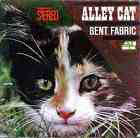Home · Listener's Guide · The Songs · Who's Who · Liner Notes · Selected Tracks · What's New · Search

Bent Fabric
- Born Bent Fabricus Bjerre, 7 December 1924, Copenhagen, Denmark
 Bent Fabric's simple piano foxtrot number, "Alley Cat," is one of those tunes we all know but hardly anyone recognizes. First hitting the radio and record charts in Denmark in 1961, by the end of 1962, it was a worldwide hit, selling over a million copies, and placing in the Top 40 in Europe, the U.K., Australia, and the United States. Simple enough for even beginning piano students to play, "Alley Cat" sold over 500,000 copies in sheet music within the first two years of its publication.
Bent Fabric's simple piano foxtrot number, "Alley Cat," is one of those tunes we all know but hardly anyone recognizes. First hitting the radio and record charts in Denmark in 1961, by the end of 1962, it was a worldwide hit, selling over a million copies, and placing in the Top 40 in Europe, the U.K., Australia, and the United States. Simple enough for even beginning piano students to play, "Alley Cat" sold over 500,000 copies in sheet music within the first two years of its publication.
As is often the case with popular entertainers in smaller countries, Fabric was a multi-talented performer. First exposed to jazz and swing music in his teens, Fabric became an avid fan, and formed his own combo soon after the end of World War Two. This group went on to make some of Denmark's earliest jazz recordings.
Fabric was interested in the recording business, and, in 1950, formed his own company, Metronome. Metronome eventually became Denmark's most successful label, and for many years, Fabric was its primary A&R man. Among his discoveries was fellow Dane, guitarist Jorgen Ingmann, whose version of the instrumental, "Apache," was a #2 hit in the U.S.
Fabric also continued to perform around Europe, both with a combo and as a soloist, and he was approached by Danish television to host a weekly variety series. For several years, Fabric's Saturday night show, "Around a Piano," was one of the most popular in Denmark. Fabric's laid-back jazz cat manner, as he hosted at the piano, dressed in a turtleneck sweater, with a cigarette hanging limply from the corner of his mouth, led some to refer to him as "the Danish Perry Como," although "the Danish Mose Allison" might be closer to the truth.
Fabric wrote many originals (for many years publishing them as "Frank Bjorn"), but somehow "Alley Cat" caught listeners like none of his other tunes. Its heavy play in Denmark soon garnered sales in neighboring countries, and within weeks, "Alley Cat" was being sold throughout Europe. It quickly hopped the Atlantic (there was a lot more openness to European pop in the late 1950s and early 1960s than today) and started catching on with the U.S. audience. As evidence of the utter unreliability of the Grammy Awards, "Alley Cat" went on to win the award for Best Rock and Roll Record of 1962. An easy-to-learn dance step was also invented to go along with it, and it's become a standard for dances--particularly at weddings--ever since. (Helen Hunt and Paul Reiser did the "Alley Cat" on an early episode of "Mad About You.")
Atlantic Records licensed a whole album of Fabric's piano numbers and it became their biggest seller for 1962, helping the Ertegun brothers weather the transition from doo-wop to soul (and who knows, maybe underwriting some Coltrane sessions to boot?). They went on to release a half dozen Fabric albums over the next 4 years, but not one came close to matching the impact of "Alley Cat." Atlantic also teamed Fabric up with their other one-shot European instrumentalist, English clarinetist Acker Bilk, but the Bilk and Fabric were no Nina and Fredrick (Atlantic's other Danish act).
With all cool cat grace, Fabric simply ambled back home, took back the mantle of national entertainer, and continued to perform on television (a new series, "The Blue Hour") and stage. He went on to compose for more ambitious settings than jazz combo, writing a musical and even a ballet based on Denmark's national fable, the Little Mermaid.
Recordings
- Alley Cat, Atco 33-148
- The Happy Puppy, Atco 33-155
- Organ Grinder's Swing, Atco 33-164
- The Drunken Penguin, Atco 33-173
- Bent Fabric and Acker Bilk Together!, Atco 33-175
- Never Tease Tigers, Atco 33-185
- Operation Lovebirds, Atco 33-202
- Relax with Bent Fabric, Atco 33-221
S p a c e A g e P o p M u s i c
Home · Listener's Guide · The Songs · Who's Who · Liner Notes · Selected Tracks · What's New · Search
Email: editor@spaceagepop.com